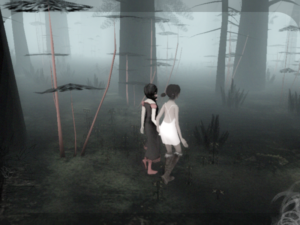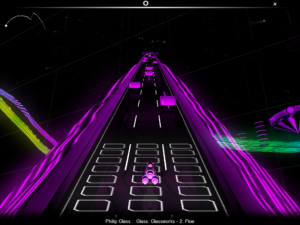I finally got this running correctly, mainly by reinstalling it from scratch (the same approach that worked for Audiosurf). The framerate still suffers when there are three characters on the screen, and the opening menu has six, giving a very poor first impression, but that doesn’t happen very often: it’s mostly solitary, and even when it isn’t, it mostly involves meeting with only one other character at a time. There are only two people in the woods other than yourself: a benevolent young lady in white, and some manifestation of the eternal principle we call the Big Bad Wolf.
But I get ahead of myself. The Path is basically the tale of Little Red Riding Hood retold as a horror story. And an arty horror story at that: the graphical style has a rough quality, with crudely-drawn text and UI elements, and elements of artificial damage reminiscent of the Silent Hill games, especially as things get more nervous: the camera goes out of focus, dust and splotches appear as on badly-preserved film, etc. The path itself starts in sunshine and flowers and childish laughter, and ends in shadow and decay.
As the game begins, you’re given a choice of six sisters, ranging in age from wide-eyed moppet to sullen adolescent to overconfident not-quite-adult, to guide to Grandmother’s menacing-looking house in the darkest part of the woods. The inappropriateness of sending any of these children into the woods alone is immediately apparent, and you’re given strict instructions to stay on the path, but the woods are clearly meant for exploring, or why would the designers put them there? And anyway, if you actually do obey the instructions, you’re told afterward that you failed. You climb into bed with Grandma (who is pale and still enough that I thought she was a corpse until she opened her eyes), and you’re given a rating of “D” and an opportunity to try again. To be regarded as successful, you have to find the Wolf.
Only the youngest sister gets a Wolf that’s visibly wolf-like; the rest get metaphorical wolves, wolves in human form. Even the woodcutter from the fairy tale is presented here as a wolf in man’s clothing. There are other things to find in the woods — landmarks, collectible flowers (You have found x of 144!), oddly abandoned objects like a piano, a syringe, a television that somehow manages to remain switched on in the middle of a forest — the details vary depending on which girl you picked, and what you find can affect what happens in Grandma’s house. Pursuing such things is a fine way to delay the inevitable, but if you want to make progress, you have to seek out and interact with the Wolf. I should mention a peculiar thing about interaction in this game: it’s passive. When you’re close enough to an object to interact with it, this fact is signaled visually with a ghost-like overlay, at which point all you do is stop walking and the rest happens automatically. This means that if a character walks close enough to you while you’re already standing still, you can wind up interacting with them inadvertently. This makes for a good bit of nervousness: around the Wolf, if you feel you’re not ready, you don’t dare to stand still.
But when you feel you’re ready, you interact with the Wolf, and there’s a cutscene in which something bad happens that you don’t quite get to see, after which you find yourself lying on the path in the rain just in front of Grandma’s house. The girl’s entire demeanor and body language is changed here: she’s broken and ashamed, and moves with painful slowness. (Even the controls for rotating the camera become sluggish.) And after the Wolf, the inside of the house is transformed into a surreal living nightmare reminiscent of an old FMV title. (Some will probably interpret this as meaning that she’s already dead and in Hell when she wakes up.) I experimented with ways to avoid going inside, but there’s no other place to go at this point. Attempting to walk into the woods makes you stumble, and laboriously walking backward along the path just led to an infinite paved road, without the payphone that you could use to chicken out in the pre-Wolf section. (At one point during this attempt, I looked at what I was doing, holding a button down to make a young girl walk slowly home in the rain after being traumatized, and realized that if someone had described this moment to me, I would have though it was parody.)
After going through the house to your doom, you return to the main menu, now one girl short, and are asked to pick another. And you continue until they’re all gone. What kind of sadist repeatedly sends girls off to get killed? Well, the player, obviously. You want to “succeed”, don’t you? There’s a whole mess of audience complicity issues here. (The scenes inside the house demand that you keep repeatedly pressing the forward button rather than just holding it down, as if to make you repeatedly reaffirm that you want to keep going.) But also, we can’t take the deaths entirely at face value, because this is a game that demands to be read at a symbolic level. The whole thing is dream-like, and not in an I-can’t-be-bothered-to-make-sense way, but in a Freudian way.
Bruno Bettelheim famously interpreted Little Red Riding Hood as a parable about puberty and the dangers that follow, a thread taken up by Sondheim and Lapine in the musical Into the Woods, where the wolf brings new meaning to the term “sexual predator” with the song “Hello Little Girl”. But while several of the wolf encounters in The Path are blatantly suggestive of seduction or rape (or the sometimes-blurry line between the two), it seems to me that the point here is larger. The youngest sister, Robin, discovers her wolf in a graveyard, where her comments show difficulty understanding the reality of death. While there, she can find a baby bird lying dead on the ground near the remains of a blue eggshell — that is, a dead robin. “Not me!” she insists. For her, the wolf represents awareness of mortality, one of the earlier horrible truths about the world that a child has to learn in the process of becoming an adult. And that’s what The Path is really about: the journey to adulthood. Sex is only part of it, albeit a large one.
For what is the path but life itself? It begins in verdant fertility, ends in decay and death. Even without the Wolf’s intrusion, Grandma’s house at the end of the path is the home of a woman at the end of her life. That’s where every little girl winds up eventually. But none of the sisters can traverse the path successfully: each is locked at one particular stage of life, and lacks experience to mature. The Wolf brings this experience through unwelcome lessons, and the result is the death of innocence, symbolized by the death of innocents. You can view the sisters as aspects of one person, at different stages, which have to be superseded.
 Given this analysis, the end result of passing through all the stages should be a complete person. And when we’re returned to the main menu after disposing of them all, instead of an empty room, we get one more role to play: the mysterious Lady in White, who’s been seen in the woods throughout the game. I’m not entirely sure I buy my own analysis at this point: the Lady in White appears no older than the sisters. But she definitely knows her way around the woods better than anyone else. In any of the previous chapters, it’s impossible to find the path once it’s out of sight behind you, even if you double back the way you came. But if you take the Lady in White by the hand, she will lead you back to the path. Even just following her around as she runs through the woods seems to be a good way to find the important places for your current character.
Given this analysis, the end result of passing through all the stages should be a complete person. And when we’re returned to the main menu after disposing of them all, instead of an empty room, we get one more role to play: the mysterious Lady in White, who’s been seen in the woods throughout the game. I’m not entirely sure I buy my own analysis at this point: the Lady in White appears no older than the sisters. But she definitely knows her way around the woods better than anyone else. In any of the previous chapters, it’s impossible to find the path once it’s out of sight behind you, even if you double back the way you came. But if you take the Lady in White by the hand, she will lead you back to the path. Even just following her around as she runs through the woods seems to be a good way to find the important places for your current character.
The game as a whole can be finished in a single sitting, especially if you don’t care about optional objectives. If you do, well, finding all 144 flowers will take quite some time; just stopping to pick up the ones you see will net you most of them, but I imagine the last few would take a systematic search. Even if you ignore them, though, it’s a bit of a relief that they’re there to provide an unambiguous game element. The previous “game” by Tale of Tales, The Graveyard, consisted entirely of walking an old woman down a path in a cemetery, sitting on a bench, watching a noninteractive video for a cheerful little song about death (or, alternately, interrupting it), and then walking back the way you came. (They later released a “full” version, available for a registration fee, in which the only change was that the woman would sometimes, at random, die while sitting on the bench. I was tempted to register it out of admiration for their audacity.) Now, in The Graveyard, there was only one path. There were things that looked like other paths leading off, and players like me certainly tried to take them. That’s what players do: they try to stretch the limits of the system. Perhaps The Path was, to some extent, designed in response to this, to take advantage of the player’s urge to disregard the author’s intention. Ironic, then, that my first reaction was to follow the path — not because I wanted to obey the instructions, but because I wanted to disregard the author’s obvious intention that I disobey them.
 Comments(2)
Comments(2)
